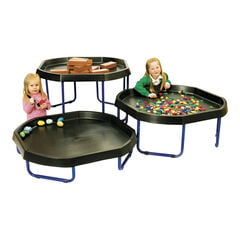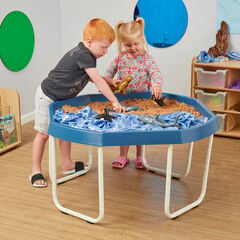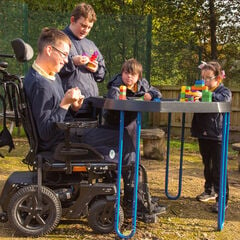In this blog, we’re going to explore the wonderful world of Tuff Trays and how they can enhance early years learning environments. As dedicated practitioners, we know that every day is an opportunity to spark creativity and engagement in our children. The Tuff Tray, which started its life as a builder’s mixing tray, has become a favourite in many early years settings, offering endless possibilities for exploration and fun.
What is a Tuff Tray?
So, what exactly is a Tuff Tray? A Tuff Tray, also known as a Tuff Spot or Active World Tray, is a sturdy, large plastic tray with raised edges. Originally designed for mixing construction materials, it has found a new purpose in early years education. Its spacious surface makes it perfect for a variety of activities, especially messy and sensory play—an essential part of early childhood development.

The Journey of the Tuff Tray – From Building Structures to Building Young Minds
The Tuff Tray’s journey from construction sites to classrooms and settings, shows just how adaptable it is. Early years practitioners and teachers quickly recognised its potential for creating engaging play areas without the mess spilling everywhere! The Tuff Tray allows children to explore freely while keeping the rest of the learning environment tidy for other types of learning. After all, we love to see children dive into their sensory experiences, but we’d prefer to keep the shaving foam away from the reading corner wherever possible!
Why use a Tuff Tray in an Early Years Setting
There are many advantages to using a Tuff Tray in early years education. Read on to find out more:
Using Tuff Trays Outside
Tuff Trays are perfect for outdoor play. They can handle everything from sunny days to light rain, making them great for activities involving water, sand, soil, or even a little mud – who doesn’t love getting a bit messy?

Encouraging Messy Play
One of the best things about Tuff Trays is how they make messy play manageable. They help minimise clean-up time and keep everything contained. With the focus on children’s engagement and learning, we can all relax a little more and concentrate on what is important.
For more inspiration on messy tuff tray ideas, read this blog – Top 10 Messy Play Ideas.
Collaborative Play
Tuff Trays also encourage collaborative play. With plenty of space for multiple children to join in, they promote social interaction, cooperation, and all the fun that comes with shared play. Children can work together, practice turn-taking, and learn to communicate effectively—all while having a great time!
Working at Different Heights
Another fantastic feature of the Tuff Tray is the option to pop it on an adjustable stand. For our youngest learners, it can be placed on the floor for easy access. As children grow, the tray can be raised to different heights using a TTS Tuff Tray stand, making it accessible for everyone, including those using wheelchairs (Tuff Tray stand developed for wheelchairs). It’s all about making play inclusive and enjoyable for every child!
Other Things to Consider
While Tuff Trays are a wonderful resource, it’s important to ensure that the focus within the tray has a clear purpose. Each activity should engage children meaningfully and support their development. Here are a few things for us to think about:
Risk of Over-Reliance on Tuff Trays
Let’s be mindful of the risk of relying too much on Tuff Trays. They’re great, but they shouldn’t replace varied learning experiences. For instance, if children could be developing their motor skills by building in a free space, let’s encourage that! If the Tuff Tray is the best option, that’s fine—just remember to think about what skills you want the children to develop.
Balancing Structured and Free Play
Sometimes, Tuff Trays can unintentionally be used like a worksheet, limiting the scope for active, self-directed play. We’ve all been there! It’s a good reminder to reflect on how we use these trays and ensure they’re enhancing, not restricting, our children’s play.
Practical Tuff Tray Ideas for Early Years Settings
Sensory Exploration
Sensory play is one of the best uses of Tuff Trays. Here are some fun materials you can fill the tray with:
- Rice and lentils
- Playdough or clay
- Soil
- Gloop
- Shaving foam
- Ice and water
- Paint and other mark-making materials
- Soap flakes
- Shredded paper
These setups engage children’s senses and encourage imaginative play and storytelling. The laughter and excitement are the best part! As well as the therapeutic benefits (for some) of feeling gloop run between your fingers or creating perfumes and different potions! Just remember to risk assess for allergies etc beforehand!
Scientific Exploration
Tuff Trays are also great for sparking curiosity and scientific exploration. Here are some activities you can try:
- Explore the properties of materials like water and ice.
- Create fizzy concoctions by mixing baking soda and vinegar.
- Add water to instant snow and watch it expand—science is fun!
- Experiment with water and different-sized containers.
- The TTS Tuff Tray Light panel can support children in exploring the properties of materials, colour mixing with translucent blocks or acetate paper, looking at images such as x-rays or observing the natural world under light e.g. looking at the veins etc in leaves and flowers.
Art and Creativity
Using Tuff Trays for art activities can be both enjoyable and practical. Children can:
- Mix colors and paint with their hands and fingers (or babies may even like to put their feet in it). You could also include powder paint and water sprays.
- Ice painting – using certain paints on an ice block instead of paper.
- Create collages, decoupage, or even try papier mâché.
- Design patterns or textures using various tools and materials such as gloop, playdough, clay or shaving foam.
This is their chance to unleash their creativity without limits!

Water Play
Tuff Trays are ideal for water play, providing a safe and contained environment for children to explore this essential element. Here are a couple of engaging ideas:
- Mini Beach Adventure: Provide children with water and sand resources to create a mini seaside experience. Add shells, toy boats, and small figurines to encourage imaginative play. This setup promotes sensory exploration as they create waterways and opens the door for language development as children describe their “beach” adventures.
- Floating and Sinking Experiment: Use the Tuff Tray to conduct simple science experiments. Provide a variety of objects and encourage children to predict and test which items will float or sink. This hands-on activity supports critical thinking and introduces basic scientific concepts in a fun, engaging way.

Small World Play
Tuff Trays offer the perfect stage for small world play, allowing children to create and explore miniature environments. The key is to provide open-ended materials, empowering children to use their imagination and take the lead in their play.
Instead of crafting elaborate, pre-designed scenes, consider offering a selection of natural materials, figurines, and loose parts. This approach allows children to construct their own worlds, encouraging creativity, problem-solving skills, and storytelling abilities. For example, you might provide:
- Pebbles, twigs, and leaves for a forest scene
- Blue fabric, shells, and toy sea creatures for an ocean adventure
- Small blocks, toy vehicles, and people figures for a city setup
By stepping back and allowing children to take control of their small world creations, we open up rich opportunities for learning and self-expression.
For more ideas and inspiration, read ‘Ideas for using your Active World Tuff Tray’ blog.
Enhancing Play with Tuff Tray Mats
To expand the possibilities of your Tuff Tray, consider incorporating some specially designed accessories. TTS offers a range of mats that can transform your Tuff Tray into different environments or learning spaces. These include:
- Road mats for transport-themed play
- Alphabet mats for literacy activities
- Number mats for mathematical exploration
- Light up panel mat
These accessories can provide a fun starting point for themed activities while still allowing plenty of room for children’s creativity and imagination to flourish.

Conclusion
Hopefully, this blog has inspired practitioners and teachers to reflect on this fantastic resource and the many ways it can be used. While the Tuff Tray offers numerous benefits and can be a valuable asset in an early years setting, their use does require some thoughtful planning. Here are a few questions for us to consider:
- What are the children learning in the Tuff Tray?
- Does the time spent on setting it up reflect the learning outcomes, or could this time be better spent elsewhere?
- Why are you putting the activity in the Tuff Tray? Is it because it enhances the learning taking place, or simply because the Tuff Tray takes up space in your environment?
If you find yourself becoming a slave to the Tuff Tray—like trying to fill it just for the sake of it or turning it into a pretty display that the children will dismantle in seconds—take a step back! Remove the pressure from yourself, pack it away, and use the space for something else until you are ready to bring it back out.
After all, this is the beauty of the Tuff Tray: it is not only versatile but also portable! It can be moved, tucked behind a cupboard, stored in the shed, or repurposed outside, freeing up space until you need it again.
By embracing the versatility of Tuff Trays and approaching their use with creativity and an open mind, we can create rich, engaging learning experiences that cater to diverse interests and developmental needs. So, let’s celebrate the Tuff Tray and the endless possibilities it brings to our early years settings! Happy playing!
Written by Michelle Reid. Michelle has over 20 years of experience working as a nursery nurse and qualified teacher in the Early Years and Primary sector.












